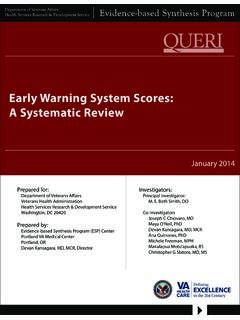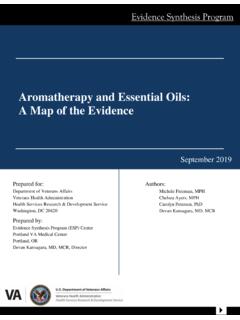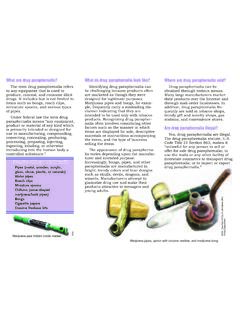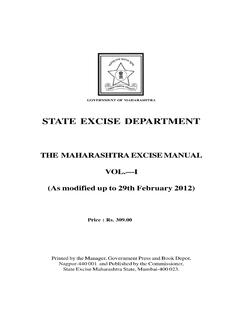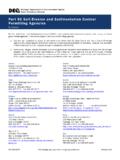Transcription of The Effectiveness and Risks of Cranial Electrical ...
1 February 2018 Prepared for: Department of Veterans Affairs Veterans Health Administration Quality Enhancement Research Initiative Health Services Research & Development ServiceWashington, DC 20420 Prepared by: Evidence-based Synthesis Program (ESP) West Los Angeles VA Medical Center Los Angeles, CA Paul G. Shekelle, MD, PhD, Director Department of Veterans Affairs Health Services Research & Development Service Evidence-based Synthesis Program The Effectiveness and Risks of Cranial Electrical Stimulation for the Treatment of Pain, Depression, Anxiety, PTSD, and Insomnia: A Systematic Review Investigators: Principal Investigator: Paul Shekelle, MD, PhD Ian Cook, MD Research Associates: Isomi M. Miake-Lye, PhD Selene Mak, PhDc Marika Suttorp Booth, MS Roberta Shanman, MLS Jessica M. Beroes, BS Cranial Electrical Stimulation Evidence-based Synthesis Program i PREFACE The VA Evidence-based Synthesis Program (ESP) was established in 2007 to provide timely and accurate syntheses of targeted healthcare topics of particular importance to clinicians, managers, and policymakers as they work to improve the health and healthcare of Veterans.
2 QUERI provides funding for ESP Centers, and each Center has an active University affiliation. Center Directors are recognized leaders in the field of evidence synthesis with close ties to the AHRQ Evidence-based Practice Centers. The ESP is governed by a Steering Committee comprised of participants from VHA Policy, Program, and Operations Offices, VISN leadership, field-based investigators, and others as designated appropriate by QUERI/HSR&D. The ESP Centers generate evidence syntheses on important clinical practice topics. These reports help: Develop clinical policies informed by evidence; Implement effective services to improve patient outcomes and to support VA clinical practice guidelines and performance measures; and Set the direction for future research to address gaps in clinical knowledge. The ESP disseminates these reports throughout VA and in the published literature; some evidence syntheses have informed the clinical guidelines of large professional organizations.
3 The ESP Coordinating Center (ESP CC), located in Portland, Oregon, was created in 2009 to expand the capacity of QUERI/HSR&D and is charged with oversight of national ESP program operations, program development and evaluation, and dissemination efforts. The ESP CC establishes standard operating procedures for the production of evidence synthesis reports; facilitates a national topic nomination, prioritization, and selection process; manages the research portfolio of each Center; facilitates editorial review processes; ensures methodological consistency and quality of products; produces rapid response evidence briefs at the request of VHA senior leadership; collaborates with HSR&D Center for Information Dissemination and Education Resources (CIDER) to develop a national dissemination strategy for all ESP products; and interfaces with stakeholders to effectively engage the program. Comments on this evidence report are welcome and can be sent to Nicole Floyd, ESP CC Program Manager, at Recommended citation: Shekelle PG, Cook I, Miake-Lye IM, Mak S, Booth MS, Shanman R, Beroes JM.
4 The Effectiveness and Risks of Cranial Electrical Stimulation for the Treatment of Pain, Depression, Anxiety, PTSD, and Insomnia: A Systematic Review. VA ESP Project #05-226; 2018. This report is based on research conducted by the Evidence-based Synthesis Program (ESP) Center located at the West Los Angeles VA Medical Center, Los Angeles, CA, funded by the Department of Veterans Affairs, Veterans Health Administration, Office of Research and Development, Quality Enhancement Research Initiative. The findings and conclusions in this document are those of the author(s) who are responsible for its contents; the findings and conclusions do not necessarily represent the views of the Department of Veterans Affairs or the United States government. Therefore, no statement in this article should be construed as an official position of the Department of Veterans Affairs. No investigators have any affiliations or financial involvement (eg, employment, consultancies, honoraria, stock ownership or options, expert testimony, grants or patents received or pending, or royalties) that conflict with material presented in the report.
5 Cranial Electrical Stimulation Evidence-based Synthesis Program ii TABLE OF CONTENTS PREFACE .. I TABLE OF CONTENTS .. II EXECUTIVE SUMMARY .. 1 Abstract .. 1 EVIDENCE REPORT .. 2 2 METHODS .. 4 Topic Development .. 4 Search Strategy .. 4 Study Selection .. 4 Data Abstraction .. 5 Quality Assessment .. 5 Data Synthesis .. 5 Rating the Body of Evidence .. 5 Peer Review .. 6 RESULTS .. 7 Literature Flow .. 7 Figure 1. Literature Flow Chart .. 8 Key Question 1: Compared to usual care, what is the Effectiveness of Cranial Electrical stimulation (CES) for the following conditions: chronic pain, depression, anxiety, PTSD, and insomnia? .. 9 Table 1. Risk of Bias Assessment for Included Studies .. 10 Table 2. GRADE Quality of Evidence Table .. 18 Key Question 2: Compared to usual care, what are the Risks of Cranial Electrical stimulation (CES) for the following conditions: chronic pain, depression, anxiety, PTSD, and insomnia?
6 18 SUMMARY AND DISCUSSION .. 20 Summary of Evidence by Key Question .. 20 Limitations .. 20 Research Gaps/Future Research .. 20 21 REFERENCES .. 22 APPENDIX A. SEARCH STRATEGIES .. 25 APPENDIX B. CRITERIA USED IN QUALITY ASSESSMENT .. 29 The Cochrane Collaboration s Tool for Assessing Risk of Bias* .. 29 APPENDIX C. PEER REVIEW COMMENTS AND AUTHOR RESPONSES .. 30 Cranial Electrical Stimulation Evidence-based Synthesis Program iii APPENDIX D. EVIDENCE TABLE FOR RCTS OF Cranial Electrical STIMULATION BY 32 APPENDIX E. CITATIONS OF FULL-TEXT EXCLUDES .. 47 Cranial Electrical Stimulation Evidence-based Synthesis Program 1 EXECUTIVE SUMMARY ABSTRACT Background Cranial Electrical stimulation (CES) is increasing in popularity as a treatment, yet of uncertain clinical benefit. Purpose To review evidence about the Effectiveness and harms of CES for patients with chronic painful conditions, depression, anxiety, PTSD, and insomnia.
7 Data Searches Searches of multiple databases from inception to 10/10/2017; reference-mining of included articles; recommendations from experts. Study Selection Randomized controlled trials of CES versus usual care or sham CES. Data Extraction Data extraction was performed in duplicate. The Principal Investigator performed the Strength of Evidence assessment. Data Synthesis 28 relevant publications from 26 RCTs met eligibility criteria. Two small RCTs compared CES to usual care, neither reported a statistically significant benefit. Four old RCTs and one modern RCT provided low strength evidence of a possible benefit of CES compared to sham in patients with anxiety and depression. RCT results were conflicting for fibromyalgia, headache, other painful conditions, depression and insomnia. There is low strength evidence that CES does not cause serious side effects. All RCTs were judged to be at high risk of bias because of the possibility of unblinding of therapy.
8 Limitations All RCTs were judged to be at high risk of bias; there were too few RCTs of the same patient population and intervention to support statistical pooling. Conclusions The evidence is insufficient to support conclusions that CES has clinically important effects on headache, fibromyalgia, neuromuscular pain, depression, PTSD, or insomnia. There is low-strength evidence for a possible beneficial effect of modest size in patients who have anxiety with depression. CES is probably safe, in that no serious side effects have been reported in RCTs, although reporting bias is present. Cranial Electrical Stimulation Evidence-based Synthesis Program 2 EVIDENCE REPORT INTRODUCTION Cranial Electrical stimulation (CES) is a non-invasive method of applying low-intensity Electrical current to the head. It is related to but distinct from other forms of transcranial Electrical stimulation including electroconvulsive therapy, transcranial direct current stimulation (tDCS), and high-definition transcranial direct current stimulation.
9 The different versions of transcranial Electrical stimulation vary in the placement of electrodes, the intensity of the current, and the waveform of the According to Guleyupoglu and colleagues, CES evolved from the concept of electrosleep, first investigated at the beginning of the 20th Most of the early research and applications occurred in Russia. Beginning in the 1960s, the concept of electrosleep became more popular in the USA. Because of the belief that the treatment did not actually induce sleep, but rather the sleep was a side effect of the relaxing effect of the current stimulation, the name was changed from electrosleep to Cranial Electrical stimulation. 1 Other proposed names, which have not persisted, included transcerebral electrotherapy and NeuroElectric Therapy. The latter is noteworthy because it gave its name to an early CES device, the Neurotone 101, which was the first device approved by the All subsequent CES devices have been cleared for marketing by FDA based on the concept of claiming equivalency to the Neurotone 101.
10 The status of Cranial Electrical stimulation devices and FDA regulation remains a matter of some controversy. After an initial burst of research activity in the 1970s and early 1980s, published research on CES entered a quiescent phase, but then resumed and accelerated beginning about 2005. CES has been proposed as a therapy for anxiety, pain, insomnia, depression, headache, fibromyalgia, and numerous other An early meta-analysis by Klawansky and colleagues2 identified 8 sham-controlled RCTs for anxiety, two RCTs for brain dysfunction, two trials for headache and two trials for insomnia. Employing an effect size approach, which pooled studies across outcomes and types of CES, the authors found a statistically significant effect size of (95% CI , ) favoring active treatment for the anxiety outcome. Pooled effects for the other conditions showed no benefit for insomnia or brain dysfunction and a small beneficial effect for headache.

